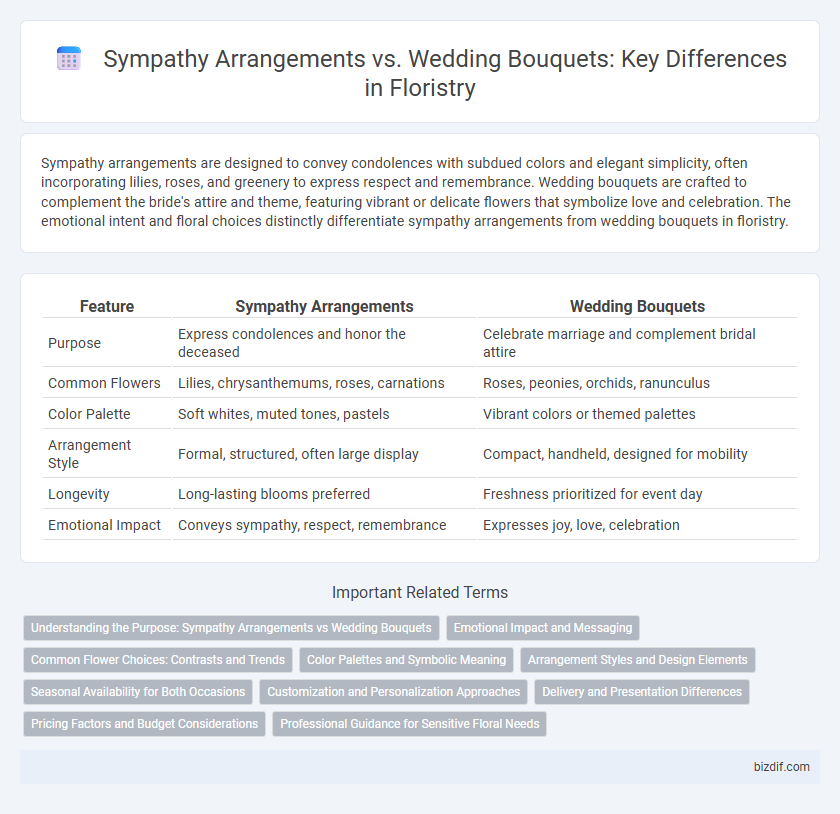Sympathy arrangements are designed to convey condolences with subdued colors and elegant simplicity, often incorporating lilies, roses, and greenery to express respect and remembrance. Wedding bouquets are crafted to complement the bride's attire and theme, featuring vibrant or delicate flowers that symbolize love and celebration. The emotional intent and floral choices distinctly differentiate sympathy arrangements from wedding bouquets in floristry.
Table of Comparison
| Feature | Sympathy Arrangements | Wedding Bouquets |
|---|---|---|
| Purpose | Express condolences and honor the deceased | Celebrate marriage and complement bridal attire |
| Common Flowers | Lilies, chrysanthemums, roses, carnations | Roses, peonies, orchids, ranunculus |
| Color Palette | Soft whites, muted tones, pastels | Vibrant colors or themed palettes |
| Arrangement Style | Formal, structured, often large display | Compact, handheld, designed for mobility |
| Longevity | Long-lasting blooms preferred | Freshness prioritized for event day |
| Emotional Impact | Conveys sympathy, respect, remembrance | Expresses joy, love, celebration |
Understanding the Purpose: Sympathy Arrangements vs Wedding Bouquets
Sympathy arrangements serve to convey condolences and offer comfort during times of loss, often featuring subdued colors and symbolic flowers such as lilies and chrysanthemums. Wedding bouquets are designed to celebrate joy and commitment, typically showcasing vibrant blooms like roses, peonies, or orchids that complement the bridal attire. Understanding these distinct purposes ensures appropriate floral choices that respect the occasion's emotional tone and cultural significance.
Emotional Impact and Messaging
Sympathy arrangements convey heartfelt condolences and offer comfort through gentle colors and serene designs, expressing respect and remembrance during times of loss. Wedding bouquets symbolize joy, celebration, and new beginnings, often featuring vibrant flowers that reflect the couple's personal style and love story. The emotional impact of sympathy arrangements centers on solace and support, while wedding bouquets emphasize happiness and unity.
Common Flower Choices: Contrasts and Trends
Sympathy arrangements often feature lilies, chrysanthemums, and carnations symbolizing peace and remembrance, while wedding bouquets commonly showcase roses, peonies, and tulips representing love and celebration. Popular trends in sympathy flowers lean towards muted tones and lush greenery to convey solemnity, whereas wedding bouquets favor vibrant colors and mixed textures for a joyful aesthetic. Both arrangements prioritize seasonal blooms to ensure freshness and availability, reflecting thoughtful floral design choices.
Color Palettes and Symbolic Meaning
Sympathy arrangements typically feature muted, soft colors such as white, pale yellow, and lavender, symbolizing peace, remembrance, and condolence. Wedding bouquets often incorporate vibrant hues like red, pink, and coral, representing love, passion, and joy. The choice of color palettes in floristry reflects the emotional significance of the event, with sympathy flowers conveying respect and mourning while wedding bouquets emphasize celebration and romance.
Arrangement Styles and Design Elements
Sympathy arrangements prioritize somber, elegant designs featuring soft hues, lush greenery, and traditional shapes like wreaths and sprays to convey condolence and respect. Wedding bouquets emphasize vibrant, personalized styles with a mix of seasonal blooms, varied textures, and intricate bindings that match the bride's theme and attire. The contrast lies in the emotional tone and floral choices, with sympathy pieces favoring subdued symbolism while wedding bouquets highlight celebration and individuality.
Seasonal Availability for Both Occasions
Sympathy arrangements often rely on seasonal blooms like lilies, chrysanthemums, and roses, which convey solemnity and respect, making availability crucial during spring and fall. Wedding bouquets showcase a broader variety of seasonal flowers such as peonies in late spring, dahlias in autumn, and ranunculus in winter, aligning with the couple's aesthetic and wedding timeline. Understanding the seasonal availability of flowers ensures both sympathy arrangements and wedding bouquets achieve their intended emotional impact and visual appeal.
Customization and Personalization Approaches
Sympathy arrangements often emphasize personalized elements such as favorite flowers, meaningful colors, and symbolic foliage to convey heartfelt condolences uniquely tailored to the deceased and their family. In contrast, wedding bouquets prioritize personalization through coordination with the wedding theme, bride's style, and seasonal blooms, ensuring a cohesive aesthetic that reflects the couple's story. Both require close collaboration with the florist to incorporate specific details, making each arrangement a distinctive expression of sentiment and occasion.
Delivery and Presentation Differences
Sympathy arrangements are typically designed for display at memorial services or funeral venues, emphasizing somber tones and large, often horizontal presentations suitable for caskets or altars, and are usually delivered early to ensure timely setup. Wedding bouquets prioritize handheld convenience and aesthetic appeal for brides, crafted with cohesive themes and colors, often delivered closer to ceremony time to ensure freshness and ease of transport. The presentation of sympathy flowers is meant to convey condolences and support, frequently arranged in wreaths or sprays, while wedding bouquets complement the bride's attire and are often accessorized with ribbons or wraps for elegance.
Pricing Factors and Budget Considerations
Sympathy arrangements often entail larger, more elaborate floral displays, which can significantly raise costs compared to wedding bouquets that are typically smaller and customized for personal style. Pricing factors for sympathy flowers include the type of blooms, arrangement size, and delivery logistics, while wedding bouquets emphasize seasonal flowers, bridal preferences, and designer fees. Budget considerations should account for the intended impact and setting; sympathy arrangements may require a higher investment to convey respect and condolences, whereas wedding bouquets balance aesthetic appeal with the overall event budget.
Professional Guidance for Sensitive Floral Needs
Sympathy arrangements prioritize conveying heartfelt condolences with subdued colors and traditional flowers like lilies and chrysanthemums, whereas wedding bouquets focus on personal expression using vibrant blooms tailored to the bride's style. Professional florists provide sensitive guidance to ensure the floral designs appropriately reflect the occasion's emotional tone while honoring cultural or personal preferences. Expert advice helps balance aesthetics and sentiment, creating meaningful, respectful arrangements for both mourning and celebration.
Sympathy Arrangements vs Wedding Bouquets Infographic

 bizdif.com
bizdif.com